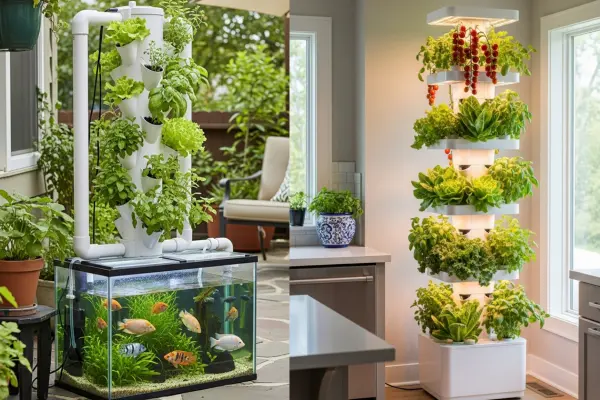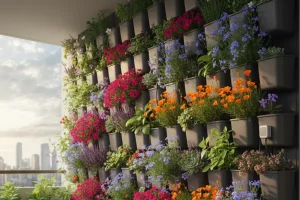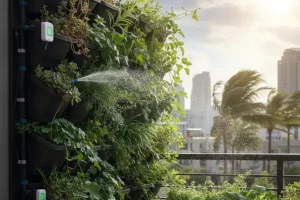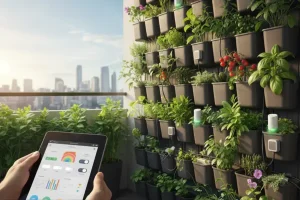Vertical gardening is growing in popularity, and it’s easy to see why. Whether you live in a small apartment or want to maximize a backyard harvest, vertical systems allow you to grow more food in less space. But once you start exploring your options, two methods stand out: hydroponics and aquaponics.
At first glance, they seem similar—both systems grow plants without soil and rely on circulating water. However, the differences between them are important and can determine which is the better fit for your space, budget, and goals. This guide compares the two approaches so you can choose confidently.
Why This Comparison Matters
Choosing between hydroponics and aquaponics isn’t just about style—it shapes how your garden works day to day. The system you pick influences layout, learning curve, and even how quickly you see harvests.
Hydroponics relies on ready-made nutrient solutions and gives very precise control, which is great for apartments or small balconies. Aquaponics pairs plants with fish, creating a living ecosystem that can be more sustainable long term but requires fish care and biological balance.
Your decision will affect:
- Startup costs: Hydroponics usually needs fewer components; aquaponics adds tanks, biofiltration, and fish.
- Day-to-day maintenance: Hydroponics means mixing nutrients and tracking pH/EC; aquaponics adds feeding, water quality checks, and fish health.
- Types of crops: Leafy greens and herbs thrive in both; heavy feeders (like tomatoes) may need stronger support and tuning.
- Long-term sustainability: Aquaponics recycles fish waste into plant food; hydroponics can conserve water with recirculating systems and careful dosing.
- Space and noise: Pumps and aeration differ; consider neighbors and living areas.
Pick the right approach at the start and you’ll save time, money, and frustration—and enjoy a smoother path to reliable harvests..
Hydroponic Vertical Gardens
How it works: Hydroponics uses nutrient-rich water instead of soil. Plants receive a carefully balanced mix of minerals directly through their roots.
Best for: Beginners, fast-growing leafy greens, and small-space gardeners.
Pros:
- Faster growth because nutrients are delivered directly
- Full control over nutrient levels
- Clean and soil-free, making it ideal for indoor use
- Compact, modular systems available for apartments or balconies
Cons:
- Ongoing cost of nutrient solutions
- Requires regular testing of pH and nutrient balance
- Dependent on pumps and electricity—failures can harm plants quickly
- Less suited for heavy-feeding or large crops such as corn or melons
Aquaponic Vertical Gardens
How it works: Aquaponics combines aquaculture (raising fish) with hydroponics. Fish waste becomes natural fertilizer for plants, while plants filter the water for the fish, creating a balanced ecosystem.
Best for: Gardeners who want a sustainable system, enjoy the idea of raising fish, and are willing to invest more time in setup.
Pros:
- Highly sustainable and environmentally friendly
- Provides two harvests: plants and fish
- Lower ongoing costs once the system is established
- Creates a natural cycle with less reliance on purchased fertilizers
Cons:
- Higher initial setup cost due to tanks and biofilters
- Requires fish care (feeding, monitoring water quality)
- Takes longer to start because bacteria need time to establish
- Plant options are more limited compared to hydroponics
Quick Comparison Table
| Feature | Hydroponics | Aquaponics |
| Startup Cost | Low to Moderate | Moderate to High |
| Ongoing Costs | Nutrient solution | Fish food (generally lower) |
| Ease of Setup | Easier for beginners | More complex |
| Best Crops | Leafy greens, herbs, strawberries | Leafy greens, basil, mint |
| Extra Harvest | None | Fish (tilapia, trout, catfish) |
| Sustainability | Moderate | High |
| Maintenance | Nutrient and pH checks | Fish care plus plant care |
Which System Should You Choose?
- Choose Hydroponics if:
- You want quick and predictable results
- You have limited space indoors or on a balcony
- You don’t want the added responsibility of raising fish
- You are completely new to vertical gardening
- You want quick and predictable results
- Choose Aquaponics if:
- You want a sustainable, eco-friendly system
- You are excited about producing both plants and fish
- You are willing to invest more time and money upfront
- You want to reduce reliance on store-bought fertilizers
- You want a sustainable, eco-friendly system
Common Mistakes to Avoid
Both systems can be highly rewarding, but new gardeners often stumble over similar issues:
- Poor Water Quality
Clean, oxygen-rich water is essential. Always test regularly and keep filters clear. - Overloading the System
Adding too many plants (or too many fish in aquaponics) disrupts the balance. Start small and expand once you gain experience. - Lack of Backup Power or Pumps
Pumps keep water flowing. A failure, even for a few hours, can harm plants. Keep spare equipment or a battery backup ready. - Neglecting Routine Testing
- In hydroponics: monitor pH and nutrient concentration weekly.
- In aquaponics: test ammonia, nitrite, and nitrate levels to protect fish.
- In hydroponics: monitor pH and nutrient concentration weekly.
FAQs
Q: Can I switch from hydroponics to aquaponics later?
Yes, but it requires adding fish tanks, biofilters, and allowing time for beneficial bacteria to establish. It’s easier to decide on aquaponics from the beginning.
Q: Do aquaponic systems smell bad?
Not if properly maintained. A healthy aquaponic system smells like fresh water, not fish.
Q: What are the best starter plants for each system?
- Hydroponics: lettuce, spinach, basil, strawberries
- Aquaponics: kale, chard, mint, basil
Q: Which system works better indoors?
Hydroponics is usually better indoors since it is more compact and doesn’t require fish tanks.
Conclusion
Both hydroponic and aquaponic vertical gardens make it possible to grow fresh, healthy food in limited space, but the choice depends on your priorities.
- If you prefer simplicity, control, and fast results, hydroponics is the best option.
- If you value sustainability and like the idea of producing both plants and fish, aquaponics is worth the investment.
Whichever system you choose, vertical gardening offers an exciting way to maximize space and enjoy fresh harvests at home.
Which system do you think fits your lifestyle better: hydroponics or aquaponics? Share your thoughts in the comments below.




